Announced roughly a year ago, the Seagate Nytro 3000 line of enterprise SAS SSDs is making its way through the market. These drives are part of an endurance-driven family of SSDs designed specifically for demanding enterprise applications and to improve TCO. The use cases include server virtualization, databases, software-defined storage, and all-flash arrays. In this review, we will be looking at the Nytro 3530, the light-endurance line aimed at OLTP and other more mainstream workloads.
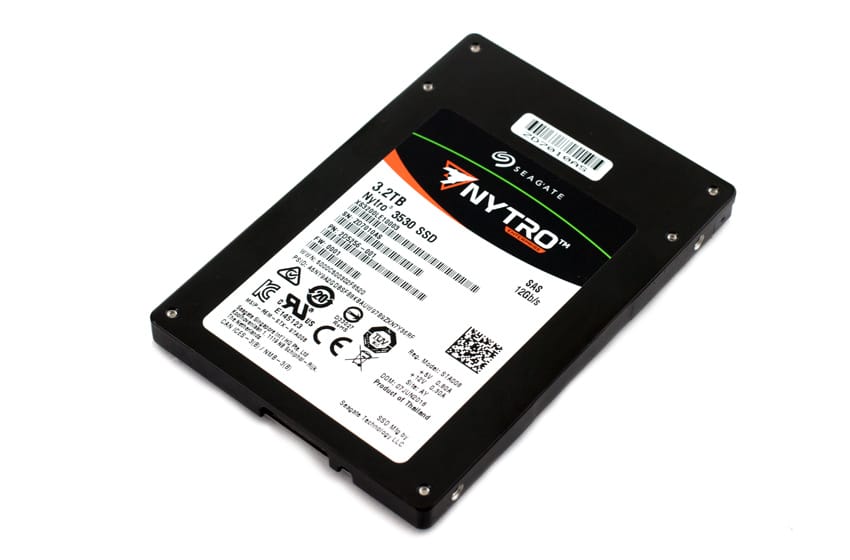
Though not as large as the 3033’s maximum capacity of 16TB, the Nytro 3530 line still offers capacities up to 3.2TB in a 2.5-inch form factor. It also offers endurance categories to match cost and performance requirements of all enterprise workloads. As far as what the Nytro 3530 is capable of in the performance column, the new Seagate drive is quoted to deliver some pretty solid numbers with 2,100MB/s and 1,260MB/s for sequential reads and writes, respectively, while random reads and writes are expected to reach up to 400,000 IOPS and 270,000 IOPS.
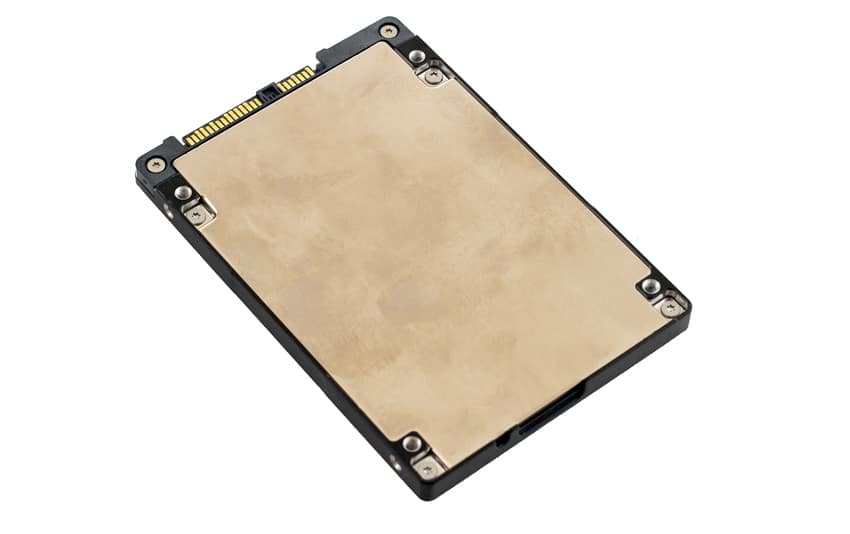
Backed by a 5-year warranty, the Nytro 3530 comes in capacities of 3.2TB, 1.6TB, 800GB, and 400GB models. We will be looking at the 3.2TB model for this review.
Seagate Nytro 3000 Specifications
| User Capacity (GB): | 3.2TB, 1.6TB, 800GB, 400GB |
| Flash Memory Technology: | 3D eMLC |
| Interface: | 12Gb/s SAS Dual-port |
| Form Factors: | 2.5 in X 15mm, 2.5 in X 7mm |
| Performance: | |
| Sequential Read: | up to 2,100MB/s |
| Sequential Write: | up to 1,260MB/s |
| Random Read: | up to 400K IOPS |
| Random Write: | up to 270K IOPS |
| Power: | |
| +5/+12V Max Start Current (A): | 0.80/0.21 |
| Configurable Power Limit Settings (W): | 9 and Max |
| Average Idle Power (W) | 4.4 |
| Lifetime Endurance (Drive Writes per Day): | 3 |
| Non-recoverable Read Errors per Bits Read: | 1 per 10E18 |
| Annualized Failure Rate (AFR): | 3 |
| Limited Warranty: | Approximately 5 years |
Performance
Testbed
Our Enterprise SSD reviews leverage a Dell PowerEdge R740xd for synthetic benchmarks. Synthetic tests that don’t require a lot of CPU resources use the more traditional dual-processor server. In both cases, the intent is to showcase local storage in the best light possible that aligns with storage vendor maximum drive specs.
Dell PowerEdge R740xd
- 2 x Intel Gold 6130 CPU (2.1GHz x 16 Cores)
- 16 x 16GB DDR4-2666MHz ECC DRAM
- 1x PERC 730 2GB 12Gb/s RAID Card
- Add-in NVMe Adapter
- Ubuntu-16.04.3-desktop-amd64
Testing Background
The StorageReview Enterprise Test Lab provides a flexible architecture for conducting benchmarks of enterprise storage devices in an environment comparable to what administrators encounter in real deployments. The Enterprise Test Lab incorporates a variety of servers, networking, power conditioning, and other network infrastructure that allows our staff to establish real-world conditions to accurately gauge performance during our reviews.
We incorporate these details about the lab environment and protocols into reviews so that IT professionals and those responsible for storage acquisition can understand the conditions under which we have achieved the following results. None of our reviews are paid for or overseen by the manufacturer of equipment we are testing. Additional details about the StorageReview Enterprise Test Lab and an overview of its networking capabilities are available on those respective pages.
VDBench Workload Analysis
When it comes to benchmarking storage devices, application testing is best, and synthetic testing comes in second place. While not a perfect representation of actual workloads, synthetic tests do help to baseline storage devices with a repeatability factor that makes it easy to do apples-to-apples comparison between competing solutions. These workloads offer a range of different testing profiles ranging from “four corners” tests, common database transfer size tests, to trace captures from different VDI environments. All of these tests leverage the common vdBench workload generator, with a scripting engine to automate and capture results over a large compute testing cluster. This allows us to repeat the same workloads across a wide range of storage devices, including flash arrays and individual storage devices. Our testing process for these benchmarks fills the entire drive surface with data, then partitions a drive section equal to 25% of the drive capacity to simulate how the drive might respond to application workloads. This is different than full entropy tests which use 100% of the drive and take them into steady state. As a result, these figures will reflect higher-sustained write speeds.
Profiles:
- 4K Random Read: 100% Read, 128 threads, 0-120% iorate
- 4K Random Write: 100% Write, 64 threads, 0-120% iorate
- 64K Sequential Read: 100% Read, 16 threads, 0-120% iorate
- 64K Sequential Write: 100% Write, 8 threads, 0-120% iorate
- Synthetic Database: SQL and Oracle
- VDI Full Clone and Linked Clone Traces
In our first VDBench Workload Analysis, Random 4K Read, the Nytro 3530 had sub-millisecond latency performance throughout the test like the other drives, while peaking at 159,720 IOPS with latency of 799.1ms.
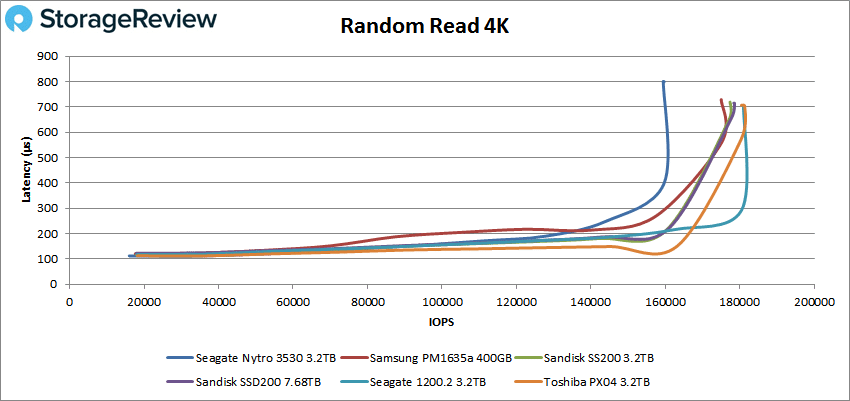
With Random 4K writes the Nytro 3530 recorded a peak score of 132,211 IOPS and a latency of 959.2ms. Again, the Seagate drive remained below the millisecond latency mark throughout the test.
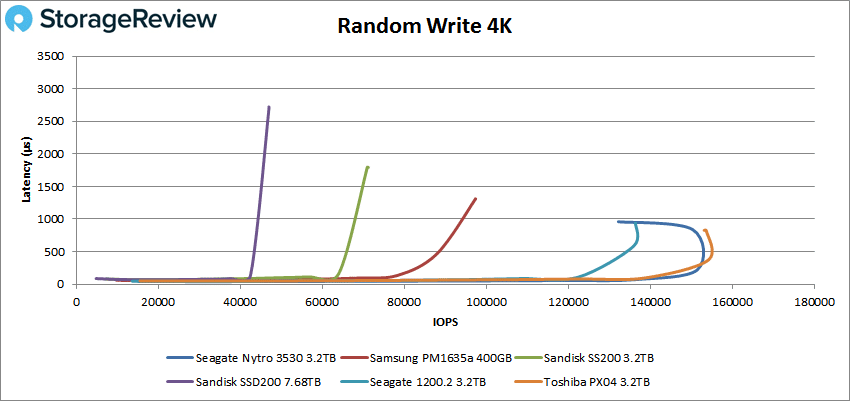
Switching over to sequential workloads, we first look at our 64K read test. In this workload, the Nytro 3530 had sub-millisecond latency for the vast majority of the test, while peaking at 995.2MB/s (or 15,293 IOPS) with a latency of 1002.8ms.
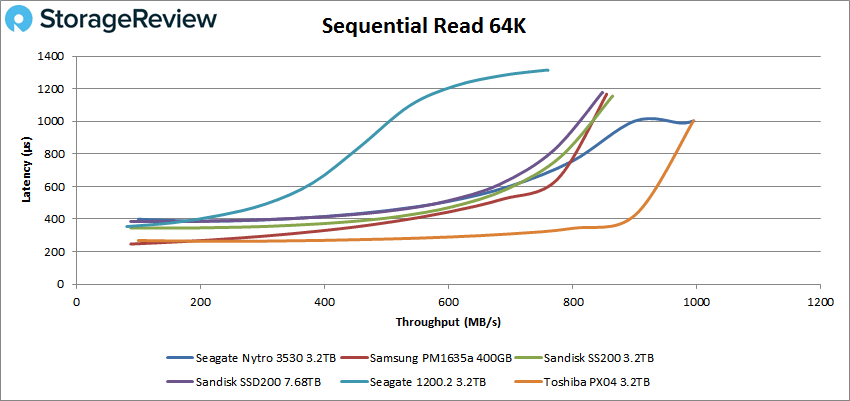
In sequential writes, the Seagate drive made it to approximately 11,589 IOPS until it surpassed a millisecond in latency while peaking at 12,327 IOPS or 770.5MB/s with 1,289ms latency.
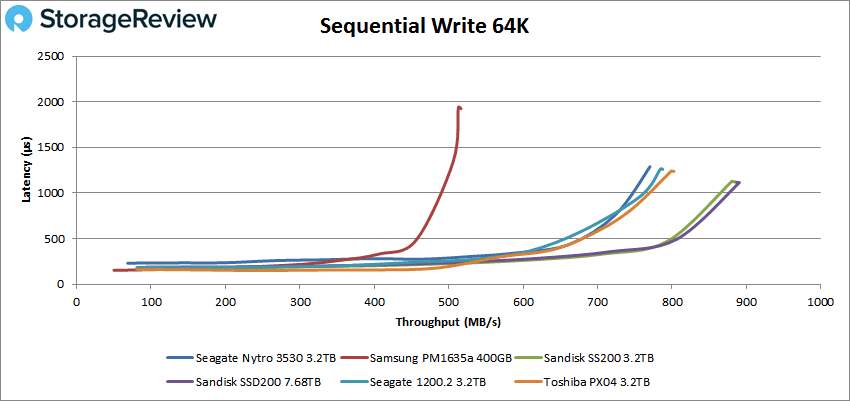
In our next set of benchmarks, we move on to our SQL workloads where the Seagate drive was able to maintain sub-millisecond latency performances throughout all three tests (hovering around the 400-450ms~ mark). In the SQL test, the Seagate drive peaked at 91,564 IOPS with a latency of 348.8ms
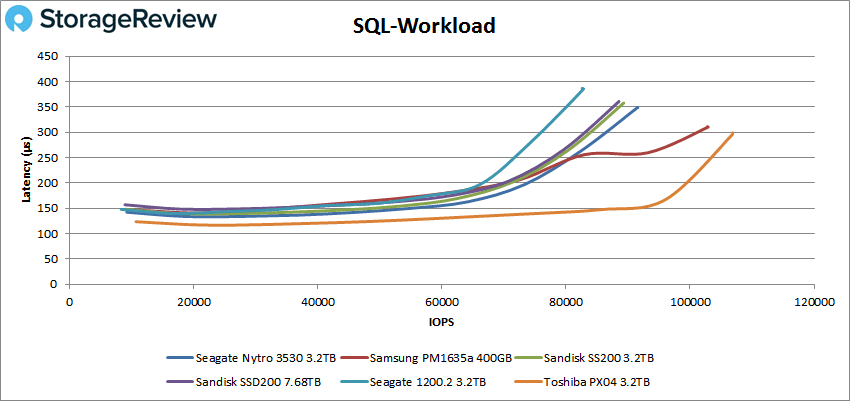
For SQL 90-10, the Seagate drive continued its solid performance with a peak of 97,433 IOPS with a latency of 327.5μs.
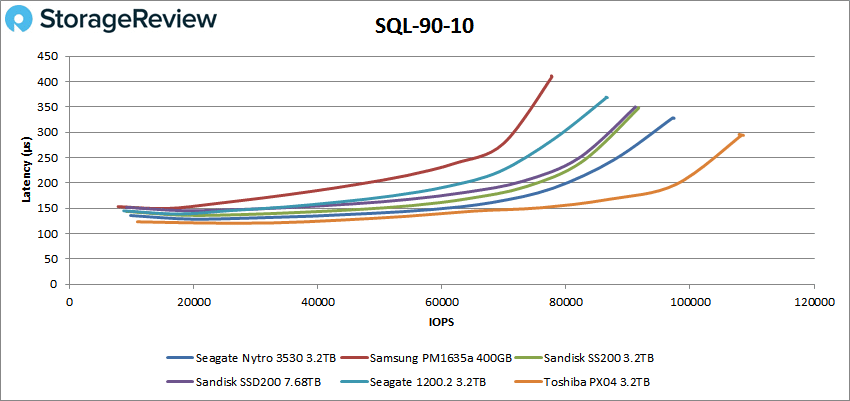
In SQL 80-20, the Nytro 3530 peaked at an impressive 110,649 IOPS and a latency of 288.1μs.
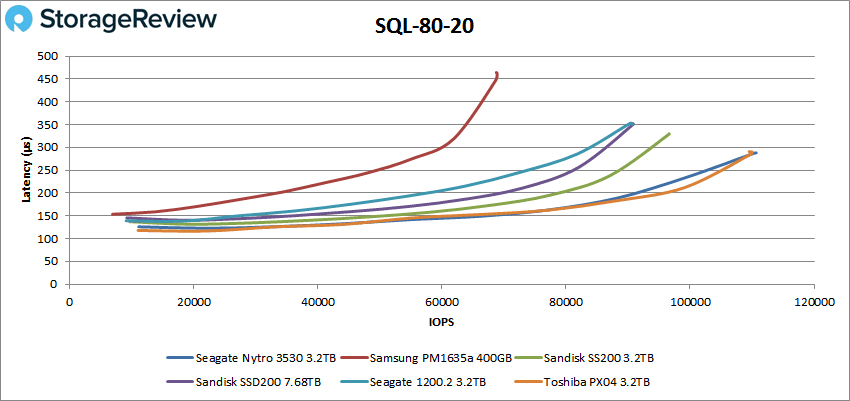
Next is the Oracle workload, which posted a peak performance and latency of 113,333 IOPS and 307ms, respectively.
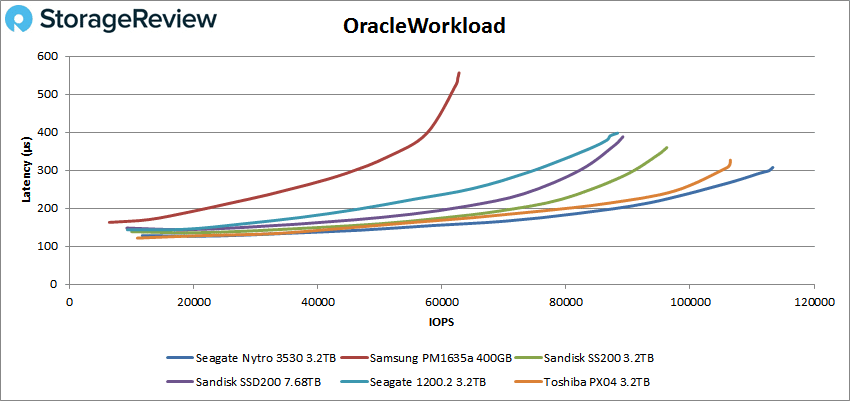
In Oracle 90-10, the Seagate drive showed peak performance of 87,831 IOPS with a latency of 250μs.
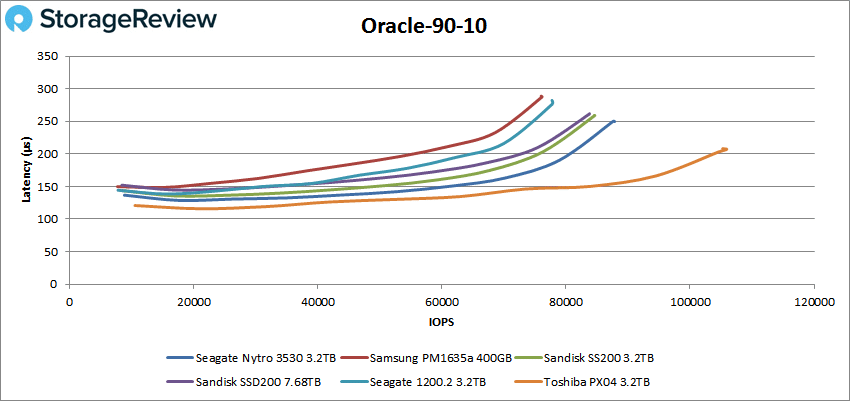
In our 80-20 test, the new Seagate drive recorded a peak performance of roughly 98,000 IOPS and the highest latency of around 222ms.
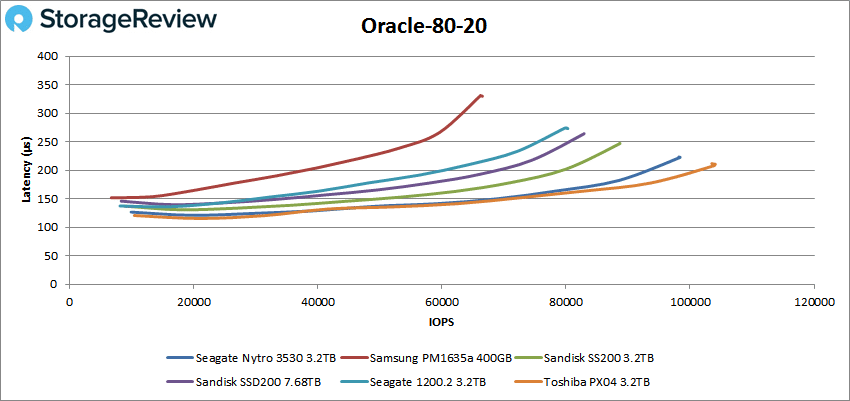
Next, we move on to our VDI clone test, Full and Linked. For VDI Full Clone Boot, the Seagate Nytro 3530 showed peak performance of 63,143 IOPS with a latency of 546ms, while maintaining sub-millisecond latency throughout the test (as well as the ones below).
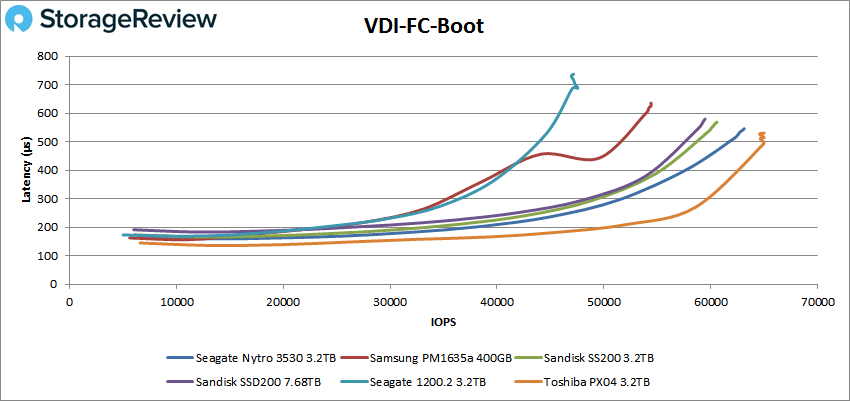
VDI FC Initial Login saw the Seagate peaking at 30,741 IOPS with a latency of about 959ms.
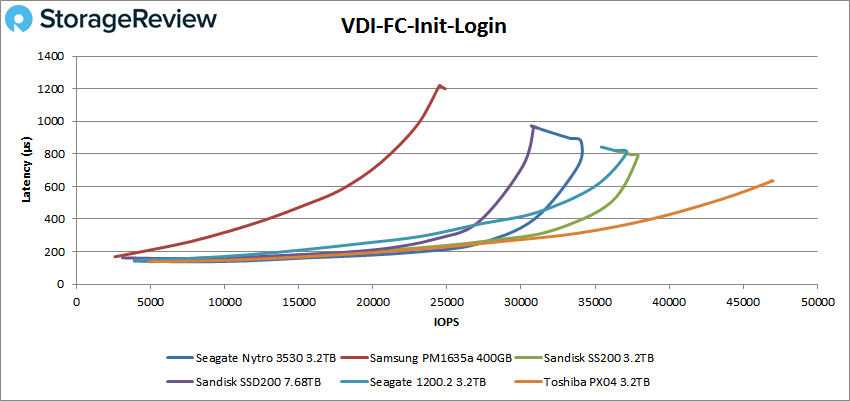
For VDI FC Monday Login the Seagate Nytro drive peaked at 40,994 IOPS with a latency of 388ms.
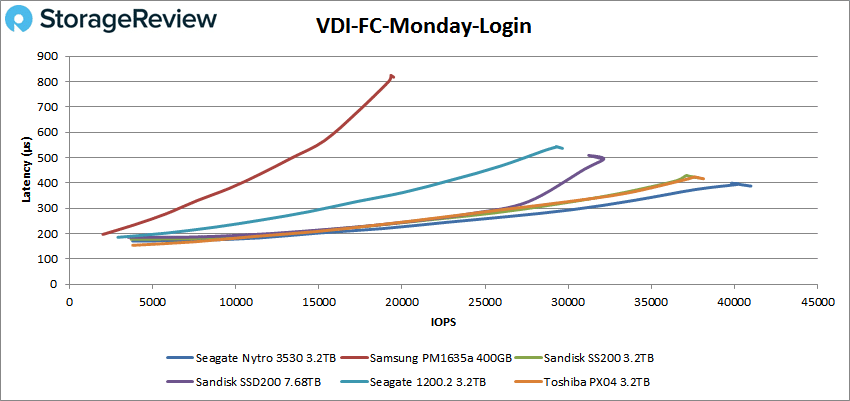
Switching over to Linked Clone (LC) we first look at the boot test. Here, the new Seagate drive peaked at 30,973 IOPS and a latency of 516ms.
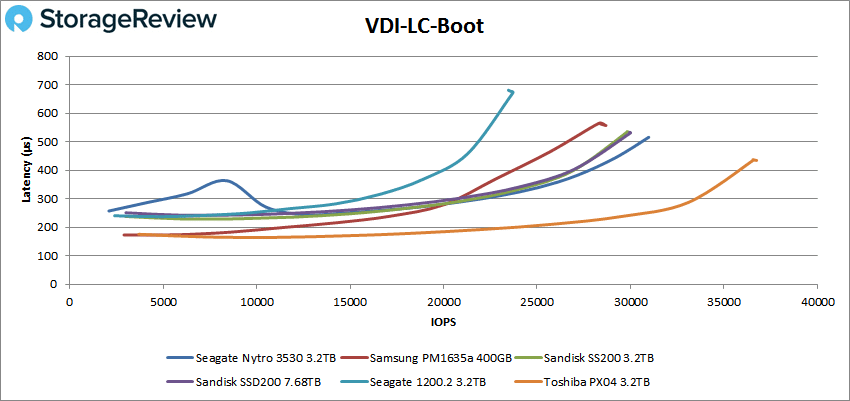
VDI LC Initial Login showed the drive’s peak performance at 22,939 IOPS and a latency of 345.3ms.
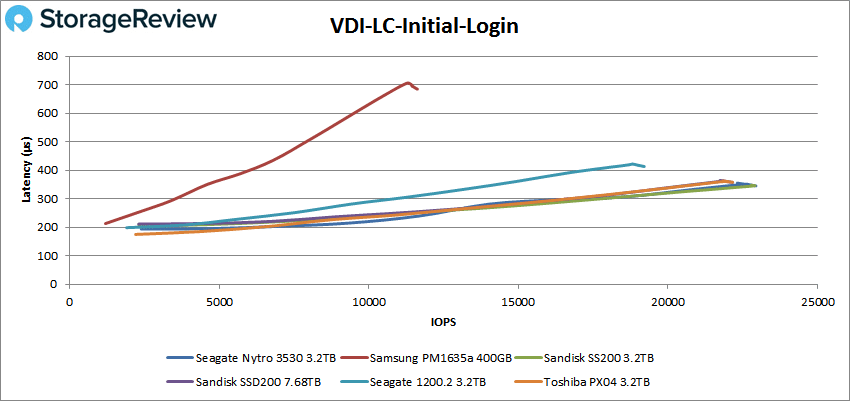
And finally, VDI LC Monday Login had the drive showed peak performance of 29,015 IOPS and a latency of 547.5ms.
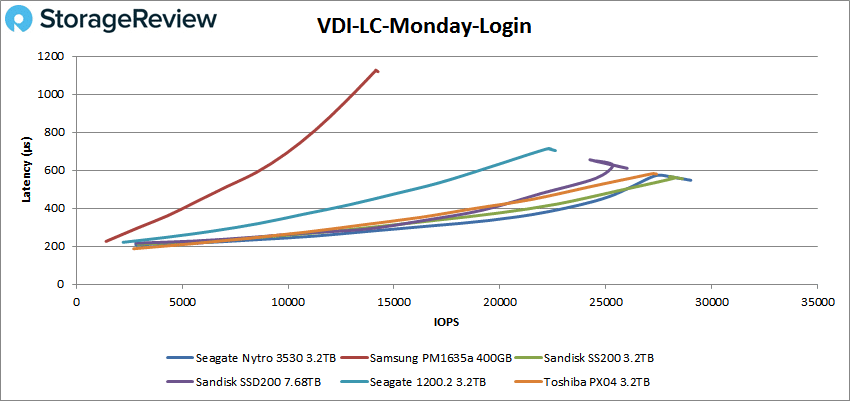
Conclusion
The Seagate Nytro 3530 is part of the company’s newest high-performance and endurance-drive line of enterprise SATA SSDs. While certain models from the 2.5-inch Nytro 3000 family offer range of capacities up to 15TB, the 3530 goes as high as 3.2TB which addresses most mainstream enterprise workloads. The drive leverages the 3D eMLC NAND for some pretty impressive performance and endurance. Seagate quotes sustained sequential speeds up to 2,100MB/s read and up to 1,400B/s write with random speeds of 98K IOPS read and 19K IOPS write (for both the 3.2TB and 1.6TB models).
During our VDBench performance benchmarks, the Nytro 3530 showed off a very good overall profile. In 4K random reads and writes, the Seagate SSD measured in at 159,720 IOPS with a latency of 799.1ms and 132,211 IOPS with a latency of 959.2ms, respectively. The 3530 hit 995.2MB/s in 64K read and 771MB/s in 64K write. In our SQL workloads, the Seagate Nytro was able to maintain sub-millisecond latency throughout the test (no more than roughly 500ms), posting 97,433 IOPS for 90-10 and 110,649 IOPS for 80-20. In both our Linked and Full Clone VDI benchmarks, the Seagate Nytro 3530 drive posted solid performance throughout.
In terms of where the Nytro 3530 slots in with the rest of the enterprise SAS world, the results are very impressive. The drive leads in a few spots and is with the pack in many others, but most importantly it never falls down in any of our benchmarks. The 3530 also makes good strides when compared to the company’s previous SAS offering, the 1200.2, which was made in conjunction with Micron. The Nytro 3530 (and the 3000 family in general) is a nice progressive step forward that reminds us Seagate can be a significant player when it comes to flash. For their part Seagate has been pretty quiet about their intentions with SSDs, but if they’re quietly working in the background to release drives like the Nytro 3530, then so be it. The 3530 is a very strong drive and clearly a leader in the entry-enterprise SAS category.




 Amazon
Amazon